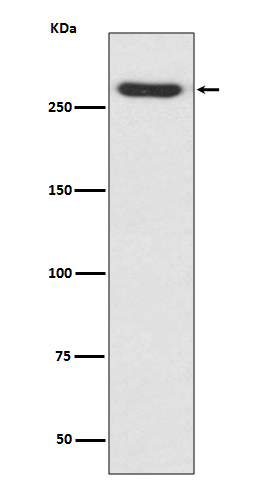产品名称
NG2 (18P16) Rabbit Monoclonal Antibody
别名
NG2; MCSP; MCSPG; MSK16; HMW-MAA; MEL-CSPG;
纯度
Affinity-chromatography
存储缓冲液
Rabbit IgG in phosphate buffered saline , pH 7.4, 150mM NaCl, 0.02% New type preservative N and 50% glycerol. Store at +4°C short term. Store at -20°C long term. Avoid freeze / thaw cycle.
Human Swissprot No.
Q6UVK1
稀释度
WB 1:500~1:2000 IHC 1:50~1:200 FC 1:50
注意事项
NG2 Antibody is for research use only and not for use in diagnostic or therapeutic procedures.
组织表达
Detected only in malignant melanoma cells.
细胞定位
Cell membrane {ECO:0000250|UniProtKB:Q00657}; Single-pass type I membrane protein {ECO:0000250|UniProtKB:Q00657}; Extracellular side {ECO:0000250|UniProtKB:Q00657}. Apical cell membrane {ECO:0000250|UniProtKB:Q00657}; Single-pass type I membrane protein {ECO:0000250|UniProtKB:Q00657}; Extracellular side {ECO:0000250|UniProtKB:Q00657}. Cell projection, lamellipodium membrane {ECO:0000250|UniProtKB:Q00657}; Single-pass type I membrane protein {ECO:0000250|UniProtKB:Q00657}; Extracellular side {ECO:0000250|UniProtKB:Q00657}. Cell surface {ECO:0000250|UniProtKB:Q00657}. Note=Localized at the apical plasma membrane it relocalizes to the lamellipodia of astrocytoma upon phosphorylation by PRKCA. Localizes to the retraction fibers. Localizes to the plasma membrane of oligodendrocytes (By similarity) {ECO:0000250|UniProtKB:Q00657, ECO:0000250|UniProtKB:Q8VHY0}
功能
Proteoglycan playing a role in cell proliferation and migration which stimulates endothelial cells motility during microvascular morphogenesis. May also inhibit neurite outgrowth and growth cone collapse during axon regeneration. Cell surface receptor for collagen alpha 2(VI) which may confer cells ability to migrate on that substrate. Binds through its extracellular N-terminus growth factors, extracellular matrix proteases modulating their activity. May regulate MPP16-dependent degradation and invasion of type I collagen participating in melanoma cells invasion properties. May modulate the plasminogen system by enhancing plasminogen activation and inhibiting angiostatin. Functions also as a signal transducing protein by binding through its cytoplasmic C-terminus scaffolding and signaling proteins. May promote retraction fiber formation and cell polarization through Rho GTPase activation. May stimulate alpha-4, beta-1 integrin-mediated adhesion and spreading by recruiting and activating a signaling cascade through CDC42, ACK1 and BCAR1. May activate FAK and ERK1/ERK2 signaling cascades.

